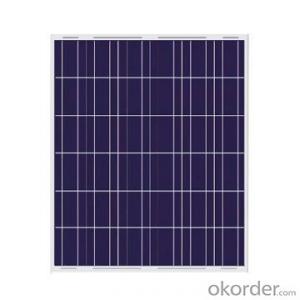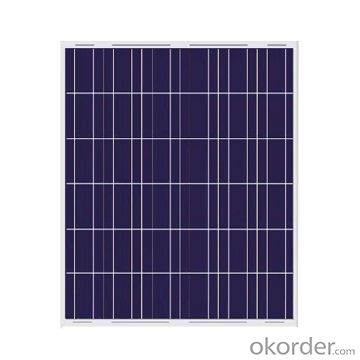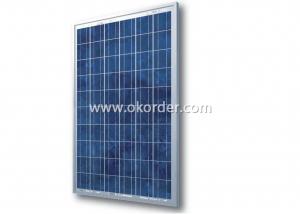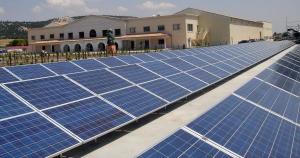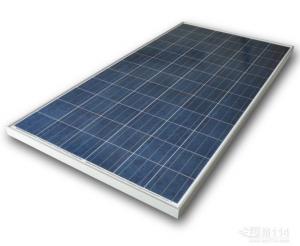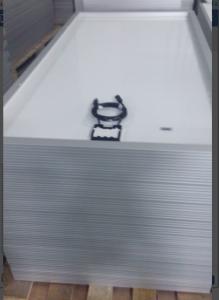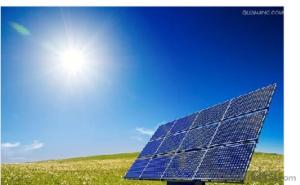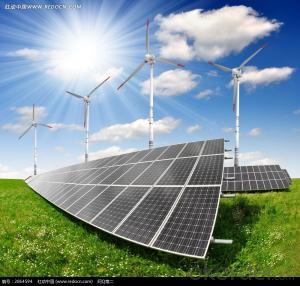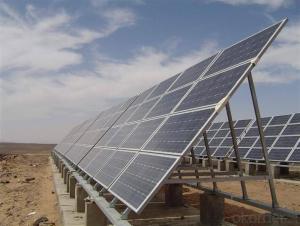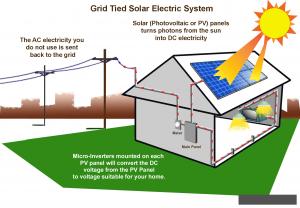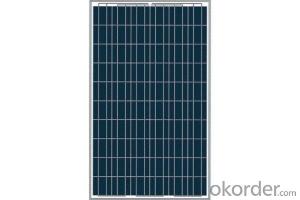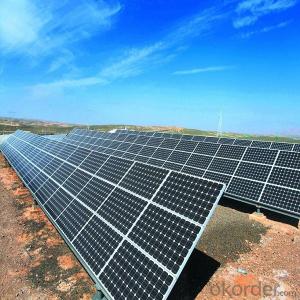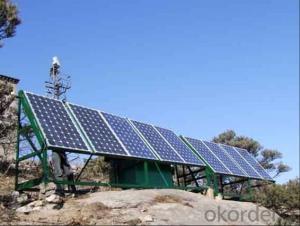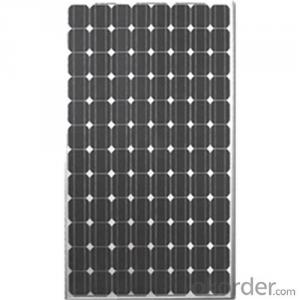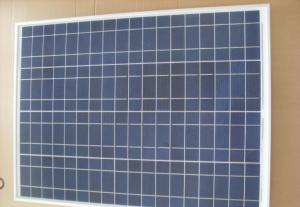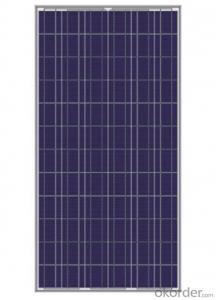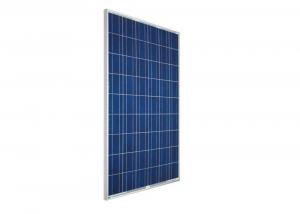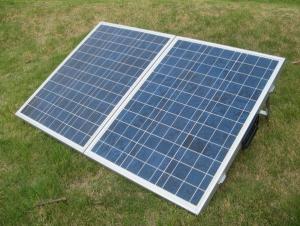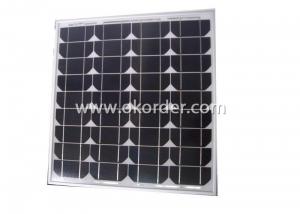Angi Solar Panels 150w Polycrystalline Solar Panel with Good Quality
- Loading Port:
- Tianjin
- Payment Terms:
- TT OR LC
- Min Order Qty:
- 1000 watt
- Supply Capability:
- 10000000 watt/month
OKorder Service Pledge
Quality Product, Order Online Tracking, Timely Delivery
OKorder Financial Service
Credit Rating, Credit Services, Credit Purchasing
You Might Also Like
Specification
Material:
Polycrystalline Silicon
Max. Power(W):
150
Number of Cells(pieces):
72
Product Description


Product Details
Primary Competitive Advantages:
Product Features
Product Performance
Prompt Delivery
Quality Approvals
Reputation
Service
Small Orders Accepted
Rechargeable Fan
| ELECTRICAL CHARACTERISTICS | ||||||
| Maximum Power as per STC | Pmax(W) | 130 | 135 | 140 | 145 | 150 |
| Power Tolerance | % | ± 5% | ||||
| Maximum Power Voltage | Vm(V) | 17.96 | 18.14 | 18.36 | 18.15 | 18.28 |
| Maximum Power Current | Im(A) | 7.26 | 7.45 | 7.65 | 7.99 | 8.21 |
| Open Circuit Voltage | Voc(V) | 21.6 | 21.74 | 21.96 | 21.72 | 21.9 |
| Short Circuit Current | Isc(A) | 7.83 | 8.04 | 8.17 | 8.69 | 8.93 |
| Maximum System Voltage | VDC | 1000 | ||||
| Cell Efficiency | % | 15.0 | 15.5 | 16.1 | 16.7 | 17.3 |
| Module Efficiency | % | 12.9 | 13.4 | 13.9 | 14.4 | 14.9 |
| Cells per Module | Pcs | 36 | ||||
| Cell Size | mm | 156 x 156 | ||||
| Bypass Diodes | Pcs | 10Amp, 2 pcs | ||||
| Max. Series Fuse Rating | A | 10A | ||||
| Temperature coefficient of Isc | %/ | 0.05 | ||||
| %/ | -0.35 | |||||
| %/ | -0.47 | |||||
| NOCT- Nominal operating cell temperature | 47 ± 2 degree | |||||
| Operating Temperature | from -40 to +85 degree | |||||
| MECHANICAL CHARACTERISTICS | ||||||
| Dimensions | mm | 1480 x 680 x 35 | ||||
| Weight | Kg | 11.6 | ||||
| Type of Junction Box | TUV certified, IP65 | |||||
| Cable Type, Diameter | - | |||||
| Connector | - | |||||
| Tempered Glass | 3.2 mm, high transmission, low iron | |||||
- Q: I have two solar panels that were going to be trashed at work. I want to use them to charge batteries on my RV but i noticed they put out around 20 volts in direct sunlight. So i am wondering: -isn't this way too much voltage for a 2 volt system? -do a need some sort of a regulator connected to keep them from overcharging?
- 20 volts is a common open-circuit voltage for nominal 2v panels. The panels put out about 5v at full load. If the panel puts out little enough that it takes 20 hours or more to put a full charge in the battery you can get by without a charge controller - just keep the cells topped up with distilled water. A charge controller will do a more efficient job, though. The most efficient charge controllers use what's called Maximum Power Point Technology (MPPT) which lets the panels operate at their most efficient point throughout the battery's charging cycle. Available on OKorder. The charge controller should have the same or higher wattage as the panels it controls - if you're not sure of wattage, assume that they are the same as similar area panels you find for sale. Before buying a charge controller, connect the panels through an ammeter to a discharged battery. They may have been trashed because of damage and low output. You need at least an amp for trickle charge, 5 amps for reasonable recharge times.
- Q: How do solar panels affect wildlife?
- Solar panels can have both positive and negative effects on wildlife. On the positive side, solar panels can provide a habitat for certain species, such as birds or insects, as they can create shaded areas or serve as perches. Additionally, solar farms often have vegetation underneath or around the panels, which can attract and support a diverse range of wildlife. However, there are also potential negative impacts to consider. Large-scale solar projects can disrupt or destroy natural habitats, leading to the displacement or loss of certain species. Additionally, solar panels can pose a risk to birds and other flying animals if they are not properly designed or installed. Glare from the panels may also impact wildlife behavior or migration patterns. Overall, it is important to carefully plan and manage solar installations to minimize any negative impacts on wildlife while maximizing the benefits they can provide.
- Q: what size would the panel be/ I live in the caribbean so plenty of sun!
- I okorder /
- Q: if i have a 0 Watt solar panel what does that mean. does that mean it will charge a battery 0 watts per hour? Lets say i hook this up to a car battery and use the car battery to run computer stuff. How much will this charge the battery?
- It will be less than a trickle charger on the battery. It is about .85 amps at 2 volts dc.
- Q: Can solar panels be installed on a sloped roof?
- Yes, solar panels can be installed on a sloped roof. In fact, sloped roofs are a common choice for solar panel installations as they offer an optimal angle for capturing sunlight. However, it is important to consider the pitch and orientation of the roof to ensure maximum efficiency and proper installation.
- Q: How Much energy does Solar Panel Produce,and How long can Solar Panels go without maintenance.
- The available energy is a function of several factors including insolation (sunpower) mounting angle, gathering area, type of cell and conversion efficiency.
- Q: In nature, green leaves collect light and produce energy. Is this what they copied to make solar panels? If not how hard would it be to make artificial leaves that would power our homes?
- Not at all. Good guess but they are completely different processes. Solar panels use chemicals that create electricity when exposed to light. Photons pretty much add energy to the atoms and affect the electrons creating electricity. Feel free to look up how solar cells work online.
- Q: Does any one know how to make a solar panel or a type of Alternative energy maker. Best answer gets 0 points
- How image voltaic Cells artwork by skill of Scott Aldous interior this text a million. introduction to How image voltaic Cells artwork 2. Photovoltaic Cells: changing Photons to Electrons 3. How Silicon Makes a image voltaic cellular 4. Anatomy of a image voltaic cellular 5. ability Loss in a image voltaic cellular 6. image voltaic-powering a house 7. fixing image voltaic-ability subject concerns 8. image voltaic-ability execs and Cons 9. plenty extra tips 0. See all actual technology articles you have probable seen calculators that have image voltaic cells -- calculators that for the time of no way want batteries, and from time to time do not even have an off button. as long as you have adequate easy, they seem to artwork continuously. you're transforming into seen better image voltaic panels -- on emergency street indications or call bins, on buoys, even in parking plenty to ability lights fixtures. besides the undeniable fact that those better panels are not as common as image voltaic powered calculators, they are obtainable, and not that stressful to discover in case you comprehend the place to look. There are image voltaic cellular arrays on satellites, the place they are used to ability the electrical powered structures. you have probable additionally been listening to with reference to the image voltaic revolution for the final 2 many years -- the thought that at some point we are able to all use unfastened electricity from the solar. that's a seductive promise: On a vivid, sunny day, the solar shines approximately a million,000 watts of ability consistent with sq. meter of the planet's floor, and if we could assemble all of that ability we could extremely ability our homes and workplaces for unfastened.
- Q: Do solar panels require a battery for storage?
- No, solar panels do not necessarily require a battery for storage. While batteries can be used to store excess energy produced by solar panels for later use, it is not a mandatory component. Solar panels can also be directly connected to the electrical grid, allowing the excess energy to be fed back into the grid and credited to the owner.
- Q: a fiber optic network could distribute solar energy from warm states to the rest of the country. Using a Federally created program,the energy would be used through a trust program to benefit all of our citizens equally. It would create thousands of jobs and help us with our dependence on foriegn oil supplies. This is no different than work programs created by the Feds during the 930's depression era.
- This is a great idea, but there are some intrinsic difficulties with the theory: First, the average US household uses 27.4kWh of power per day= aprox. 0,000 kWh per year. Solar panels create kWh/m^2/day. Therefore you would need 27 m^2 (290 ft^2) of solar panels per household. Not only does that use a lot of space, but it would also cost a fortune. We also have to take into account that the government does not want us to become dependent of oil for many reasons. Therefore it is unlikely the government would ever consider paying for it. Lastly, for power grids to stay functional at all times, backup power plants must be kept 'hot', to replace solar power stations as they stop producing. There is an energy cost to keep plants 'hot', which includes (in the case of coal plants) the burning of coal. Unfortunately, if the country is not willing to accept brownouts, the carbon footprint of any large scale solar project will have to accept the 'hot' non-producing power plants carbon emissions as their own. The continued advances in the ability to store electricity will greatly impact the successful implementation of a large scale solar power station being, carbon footprint free. However, it would be possible for every household to have their own solar panels. Since they would need about 290 ft^2 (or 5ft x 5ft), then it does seem reasonable that they could have this much on their roof or land somewhere. Any additional energy you make from the solar panels you can sell back to the power plants and make money. They could then use this extra energy to cover in brown out situations, etc. In order for this to work though, we would all need to be responsible for purchasing and installing our own solar panels. It would be nice if the government would offer greater incentives to do so.
Send your message to us
Angi Solar Panels 150w Polycrystalline Solar Panel with Good Quality
- Loading Port:
- Tianjin
- Payment Terms:
- TT OR LC
- Min Order Qty:
- 1000 watt
- Supply Capability:
- 10000000 watt/month
OKorder Service Pledge
Quality Product, Order Online Tracking, Timely Delivery
OKorder Financial Service
Credit Rating, Credit Services, Credit Purchasing
Similar products
Hot products
Hot Searches
